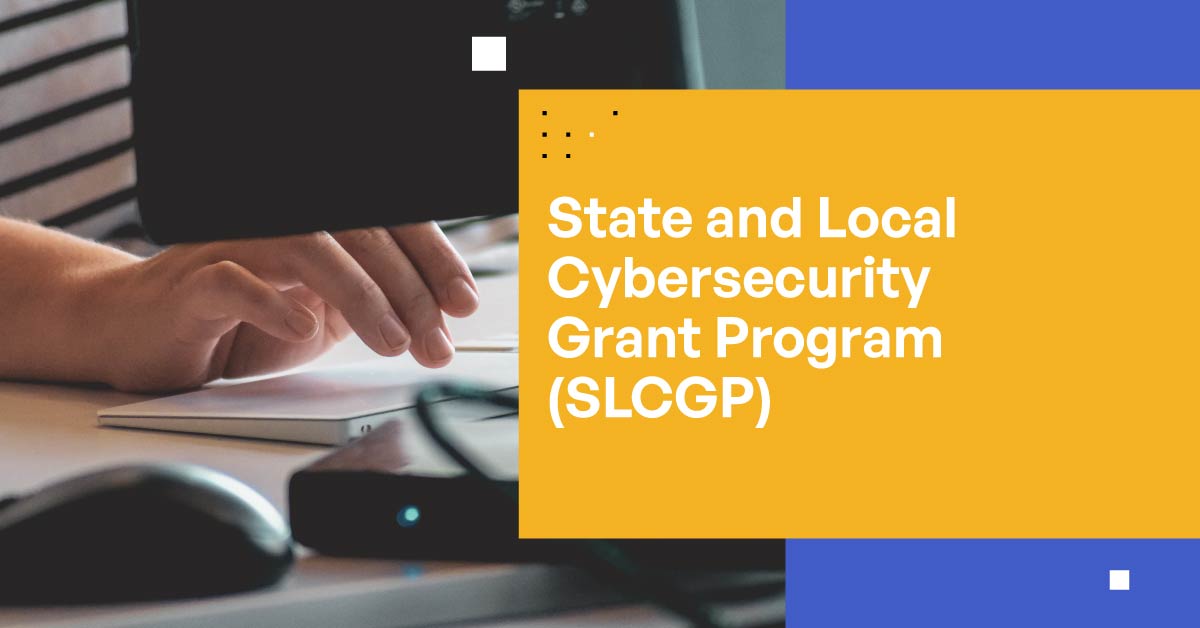Understanding the State and Local Cybersecurity Grant Program (SLCGP)
Cyberspace security has become a critical concern for governments at all levels. State and local governments, in particular, face increasing threats from cyberattacks that can compromise public services and infrastructure. For example, the The State of Ransomware in State and Local Government 2022 by Sophos found that 58% of local government organizations were hit by ransomware in 2021, up from 34% in 2020. This demonstrates that adversaries have become considerably more capable of executing the most significant attacks at scale.

To address this pressing issue, the Department of Homeland Security (DHS), in September 2022, established a first-of-its-kind State and Local Cybersecurity Grant Program (SLCGP) specifically for state, local, tribal, and territorial (SLTT) governments across the country. This article provides a comprehensive understanding of the SLCGP, including what it means, what it is set out to achieve, its funding allocation, eligibility criteria, administration, and oversight.
What Is the State and Local Cybersecurity Grant Program (SLCGP)?
The SLCGP is a funding opportunity provided by the DHS for state, local, tribal, and territorial (SLTT) governments. The grant aims to enhance cybersecurity capabilities and infrastructure at the SLTT level to protect against cyber threats and incidents.
SLCGP provides funding for activities that improve the cybersecurity posture of SLTT governments, including planning, training, and exercises. It encourages collaboration and coordination between SLTT governments and other key stakeholders, such as law enforcement agencies, emergency management agencies, and information-sharing organizations.
The program emphasizes the importance of risk assessment and mitigation, as well as the development of cybersecurity strategies and plans. It supports the implementation of cybersecurity best practices, the deployment of advanced tools and technologies, and the enhancement of incident response capabilities.
SLCGP is competitive, and applicants are required to submit applications that address specific priorities and objectives outlined by DHS. The program also promotes the adoption and implementation of standards and frameworks like the National Institute of Standards and Technology Cybersecurity Framework (NIST CSF). Through SLCGP, DHS aims to strengthen the overall cybersecurity posture of SLTT governments, enhance their ability to prevent and respond to cyber incidents, and safeguard critical infrastructure and sensitive content within their jurisdictions.
State and Local Cybersecurity Grant Program Funding Allocation and Sources
The SLCGP funding allocation involves a two-step process. First, the Department of Homeland Security allocates funding to each state and territory based on a formula that considers their population size and risk profile. Second, the states and territories distribute these funds to local governments and entities within their jurisdiction. The allocation is done through a competitive grant application process, where recipients provide project proposals detailing their cybersecurity needs. The sources of funds for the SLCGP include appropriations made by Congress, specifically designated for cybersecurity initiatives. Additionally, any unobligated funds from the previous fiscal year may be carried over to support future grants.
Eligibility Criteria for State and Local Government Agencies
To be eligible for this program, states, territories, federally recognized tribal governments, and local government agencies are required to meet certain criteria. These criteria include having an established and functioning cybersecurity program, actively participating in the Department of Homeland Security’s integrated cybersecurity initiatives, and possessing an approved cybersecurity strategy and implementation plan. Applicants must also demonstrate their commitment to addressing cybersecurity vulnerabilities, exhibit a clear understanding of their cyber risk landscape, and possess the capability to effectively manage federal grant funds. Compliance with the eligibility criteria ensures that the funds are directed toward entities committed to enhancing their cybersecurity posture. Other eligibility criteria include:
- Jurisdiction: The program is open to all U.S. states, territories, and eligible federally recognized tribal governments.
- Executive Leadership Commitment: Applicants must demonstrate executive leadership commitment and support for the cybersecurity initiatives within their jurisdiction.
- Security Assessment: Applicants are required to have conducted a comprehensive cybersecurity risk assessment within the past three years.
- Cybersecurity Strategy: Applicants must develop a well-defined and documented cybersecurity strategy that aligns with national cybersecurity goals.
- Technology and Capabilities: Eligible agencies must possess or have plans to acquire cybersecurity tools, technologies, and capabilities to enhance their cybersecurity posture.
- Information Sharing: Applicants must demonstrate a willingness and capability to actively participate in information sharing and collaboration efforts with other jurisdictions and federal agencies to improve cybersecurity preparedness.
- Budget: Applicants should provide a detailed budget plan that clearly outlines the proposed use of grant funds and demonstrates alignment with program priorities.
Why Is Cybersecurity Important for State and Local Government Agencies’ Systems?
State and local government networks are vulnerable to a wide range of cyber threats. These vulnerabilities can arise from outdated or insecure systems, inadequate security measures, lack of cybersecurity awareness among employees, and the increasing sophistication of cybercriminals. Cyberattacks on state and local government systems can have severe implications for public services and infrastructure. These attacks can disrupt essential services such as emergency response systems, healthcare facilities, transportation networks, and utilities. The consequences can include delays in emergency response, compromised public safety, and economic losses.
Cyberattacks can have significant financial and reputational consequences for state and local governments. The cost of recovering from an attack can be substantial, including expenses related to incident response, recovery, and system upgrades.
Cybersecurity is important in state and local government agencies’ systems for several reasons:
1. Strong State and Local Cybersecurity Programs Protect Sensitive Content
State and local government agencies handle a vast amount of sensitive information, including citizens’ personal records, financial data, and government secrets. Cybersecurity measures help safeguard this data from unauthorized access, theft, or manipulation by cybercriminals.
2. Strong State and Local Cybersecurity Programs Preserve Public Trust
State and local government agencies play a significant role in providing essential services to citizens, such as healthcare, education, and public safety. If their systems are compromised, it can lead to disruptions in service delivery and erode public trust. Implementing robust cybersecurity measures helps maintain the public’s confidence in the government’s ability to protect their data and ensure the smooth functioning of critical services.
3. Strong State and Local Cybersecurity Programs Prevent Financial Losses
Cyberattacks can have severe financial implications for state and local government agencies. Costs associated with data breaches, system downtime, restoration, and legal consequences can be substantial. By investing in cybersecurity, agencies can reduce the risk of financial losses resulting from cyber incidents.
4. Strong State and Local Cybersecurity Programs Protect Against Cyber Threats
State and local government agencies are prime targets for cybercriminals due to the amount of valuable data they possess. These agencies often face a wide range of threats, including ransomware attacks, phishing attempts, and data breaches. Implementing cybersecurity measures, such as firewalls, encryption, and intrusion detection systems, helps detect and mitigate these threats, reducing the vulnerability of government systems.
5. Strong State and Local Cybersecurity Programs Enable Compliance With Data Privacy Regulations
State and local government agencies are subject to various data protection and privacy regulations, such as the Health Insurance Portability and Accountability Act (HIPAA) and International Organization for Standardization (ISO) 27000 standards (ISO 27001). Implementing cybersecurity measures ensures compliance with these regulations and helps avoid penalties or legal consequences for noncompliance.
6. Strong State and Local Cybersecurity Programs Bolster National Security
State and local government agencies’ systems are interconnected with federal systems and critical infrastructure. A cyberattack in one agency’s system can potentially have ripple effects, compromising national security. By prioritizing cybersecurity, state and local government agencies contribute to overall national cybersecurity efforts and help protect the country’s critical infrastructure from potential cyber threats.
What Are Some Best Practices for a Successful SLCGP Cybersecurity Grant Program Implementation?
To ensure a successful implementation of the SLCGP grant program for state and local government agencies, it is essential to follow certain best practices. These practices are designed to enhance cybersecurity measures, improve response capabilities, and mitigate potential cyber threats. Here are some recommended best practices:
| Develop a Comprehensive Cybersecurity Strategy | • Define clear objectives and goals for the program. • Establish a governance structure and designate responsible personnel. • Conduct a thorough risk assessment to identify vulnerabilities and prioritize actions. |
| Foster Partnerships and Collaboration | • Engage with local and state government agencies, private sector organizations, and other stakeholders to share information and resources. • Collaborate with cybersecurity experts and industry professionals to leverage their expertise and best practices. • Establish information-sharing mechanisms to exchange insights on emerging threats and vulnerabilities. |
| Prioritize Training and Awareness | • Provide regular cybersecurity training to employees and stakeholders to enhance cyber hygiene practices and awareness. • Develop and implement incident response plans and conduct regular exercises to ensure readiness. |
| Invest in Technology Infrastructure | • Upgrade and maintain secure and resilient network infrastructure. • Implement multi-factor authentication, encryption, and other security controls. • Deploy advanced threat detection and prevention systems to identify and respond to potential cyber threats. |
| Enhance Incident Response Capabilities | • Establish a dedicated cybersecurity incident response team. • Develop an incident response plan that includes clear roles, responsibilities, and escalation procedures. • Regularly test and update the incident response plan based on lessons learned and emerging threats. |
| Regularly Assess and Update Security Measures | • Conduct periodic security assessments and audits to identify vulnerabilities and ensure compliance with industry standards. • Regularly update and patch systems and applications. • Implement continuous monitoring and threat intelligence capabilities to detect and respond to potential cyber threats in real time. |
By adhering to these best practices, state and local government agencies can enhance their cybersecurity posture and effectively utilize the SLCGP to protect critical infrastructure, sensitive data, and citizen privacy from cyber threats.
Kiteworks Helps State and Local Government Agencies Protect Their Constituents and Sensitive Content Communications
State, local, tribal, and territorial government agencies can look to Kiteworks to protect their sensitive content communications for eligibility with the SLCGP grant program. The Kiteworks Private Content Network provides a unified platform for government agencies to manage, track, control, and secure sensitive content communications. The Kiteworks platform enables zero-trust policy management across all communication channels including email, file sharing, managed file transfer, web forms, and application programming interfaces (APIs), providing comprehensive audit logs for governance tracking and reporting.
The Kiteworks platform empowers government agencies to demonstrate compliance with data privacy regulations like NIST, the Federal Information Security Modernization Act (FISMA), the Financial Industry Regulatory Authority (FINRA), SOC 2, HIPAA, and state-level data protection regulations, among others. Kiteworks also offers advanced security features, including a hardened virtual appliance, an embedded network firewall, a web application firewall (WAF), an antivirus engine, end-to-end encryption, AI-enabled anomaly detection, and integrated security capabilities like content disarm and reconstruction (CDR), data loss prevention (DLP), and advanced threat protection (ATP).
Kiteworks provides government agencies with multiple secure deployment options, including on-premises, private cloud, and hosted. The platform is an excellent solution for sensitive content communication within the state, local, tribal, and territorial government agencies.
To learn more about how the Kiteworks Private Content Network can help state, local, tribal, and territorial agencies comply with the SLCGP grant program requirements, schedule a custom demo today.

